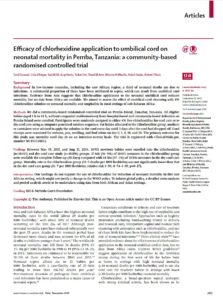
Background
In low-income countries, including the east African region, a third of neonatal deaths are due to infections. A substantial proportion of these have been attributed to sepsis, which can result from umbilical cord infections. Evidence from Asia suggests that chlorhexidine application to the neonatal umbilical cord reduces mortality, but no data from Africa are available. We aimed to assess the effect of umbilical cord cleansing with 4% chlorhexidine solution on neonatal mortality and omphalitis in rural settings of sub-Saharan Africa.
Methods
We did a community-based randomised controlled trial on Pemba Island, Zanzibar, Tanzania. All eligible babies (aged 1 h to 48 h, without congenital malformations) from hospital-based and community-based deliveries on Pemba Island were enrolled. Participants were randomly assigned to either 4% free chlorhexidine for cord care or to dry cord care using a computer-generated random sequence. For babies allocated to the chlorhexidine group, mothers or caretakers were advised to apply the solution to the cord every day until 3 days after the cord had dropped off. Cord stumps were examined for redness, pus, swelling, and foul odour on day 0, 1, 4, 10, and 28. The primary outcome for this study was mortality until day 28 on an intention-to-treat basis. The trial is registered with ClinicalTrials.gov, number NCT01528852.
Findings
Between May 19, 2011, and Aug 31, 2014, 36 911 newborn babies were enrolled into the chlorhexidine (n=18 015) and dry cord care study (n=18 896) groups. 17 468 (96·9%) of 18 015 neonates in the chlorhexidine group were available for complete follow-up (28 days) compared with 18 384 (97·3%) of 18 896 neonates in the dry cord care group. Mortality rate in the chlorhexidine group (10·5 deaths per 1000 livebirths) was not significantly lower than that in the dry cord care group (11·7 per 1000 livebirths; relative risk 0·90, 0·74-1·09; p=0·27).
Interpretation: Our findings do not support the use of chlorhexidine for reduction of neonatal mortality in this east African setting, which might not justify a change in the WHO policy. To inform global policy, a detailed meta-analysis and pooled analysis needs to be undertaken using data from both African and Asian settings.